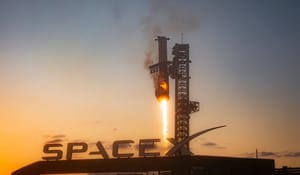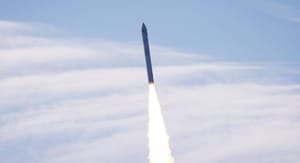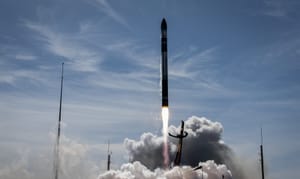
A little over a month ago, SpaceX flew the fifth flight test of its Starship-Super Heavy launch vehicle. Since the previous flight test, the company has been working quickly towards the sixth flight test and announced today that this mission could occur as soon as November 18th.
This flight test is expected to be performed by Ship 31 and Booster 13. These vehicles have already performed static fire tests and had cryogenic propellants loaded into the vehicles for testing. SpaceX did not perform a wet dress rehearsal for the last flight, so it is unlikely that one will occur for flight six.
Unlike the last flight, SpaceX is planning to relight a Raptor engine in space. Relighting a Raptor engine in space is believed to be a needed milestone before Starship is allowed to enter orbit on a future flight. This test had been planned for Starship's third flight test, but it did not occur due to uncontrolled rolls during its coast phase in space.
SpaceX is also planning on removing parts of Ship 31's heatshield and reentering at a steeper angle for the sixth flight, with the company's reasoning as follows:
"The flight test will assess new secondary thermal protection materials and will have entire sections of heat shield tiles removed on either side of the ship in locations being studied for catch-enabling hardware on future vehicles. The ship also will intentionally fly at a higher angle of attack in the final phase of descent, purposefully stressing the limits of flap control to gain data on future landing profiles."
The sixth flight test will also be hoping to reenter the atmosphere in daylight, to allow for better visual observations during the most unknown part of Starship's flight profile. To allow for a daylight reentry, liftoff is planned for 16:00 pm U.S. Central Time, or 22:00 pm Universal Coordinated Time.
Thousands of distinct vehicle and pad criteria had to be met prior to catching the Super Heavy booster. Thanks to the tireless work of SpaceX engineers, we succeeded with catch on our first attempt. pic.twitter.com/6wa5v6xHI0
— SpaceX (@SpaceX) October 13, 2024
Super Heavy Booster 12 during its landing burn and tower catch for the fifth flight test, via SpaceX on X.
SpaceX is also planning to catch Super Heavy Booster 13 during the sixth flight test, gathering more data for 'rapid reuse' repeating the technical marvel from the last flight. Improvements have also been made for unloading propellant after the booster is caught by the launch tower. Thousands of criteria, and a command from the ground, will still be needed before Booster 13 is caught.
The sixth flight test will also be the final mission for a 'Block 1' Starship second-stage. Flight seven and beyond will be using 'Block 2' Starship second-stages, which feature redesigned forward flaps, larger propellant tanks, and a more advanced heat shield.
In a first for the Starship program, SpaceX has a launch license for this mission already. The license for flight six was granted along with flight five's, despite some changes to the flight plan.
What is Starship-Super Heavy?
Starship-Super Heavy is SpaceX's in-development fully reusable super heavy-lift launch vehicle and the largest rocket currently flying. SpaceX is currently aiming to have the launch vehicle deliver one-hundred and fifty tons to low Earth orbit while reused or two-hundred and fifty tons when expended, although there are rumors from SpaceX of an expendable payload capacity of three-hundred tons.
On the launch pad, Starship-Super Heavy is one-hundred and twenty-one meters tall and weighs 5,000,000 kilograms fully fuelled. The diameter of both vehicles is nine meters, excluding aerodynamic control surfaces.
What is Starship?

Starship is the second-stage of the Starship-Super Heavy launch vehicle and is planned to be capable of multiple missions into orbit, after a short refurbishment. The vehicle is fifty meters tall and nine meters in diameter, excluding its four aerodynamic control surfaces. Fully fuelled with liquid methane and liquid oyxgen Starship is believed to weigh 1,300,000 kilograms with an approximate weight of 100,000 kilograms unfuelled.
The Starship second-stage is powered by three sea-level Raptor engines along with three vacuum-optimized Raptor engines. These sea-level engines are believed to generate 230 tons of thrust each with the vacuum-optimized engines generating 258 tons of thrust each for a total combined 1,500 tons of thrust for Starship. The vacuum-optimized Raptors are unable to gimbal requiring the sea-level Raptors for control of the second-stage on ascent and landing.
In order to survive re-entry for reuse, Starship has several thousand thermal protection tiles on one side of the vehicle and on all four of its aerodynamic control surfaces. The four control surfaces help guide the vehicle during re-entry and prior to landing inside the atmosphere at a pre-determined location. Starship also has a series of small thrusters to control the vehicle in space before re-entry.
SpaceX is believed to be working on a few variants of Starship for use as a Moon lander, propellant tanker, space station, Mars lander, and as a crewed spacecraft.
What is Super Heavy?

Super Heavy, also called 'the Super Heavy booster', is the first-stage of SpaceX's Starship-Super Heavy launch vehicle. The giant Super Heavy first-stage is planned to be capable of multiple flights per day with minimal refurbishments and inspections. The vehicle is seventy-one meters tall and nine meters in diameter, excluding its four grid fins and chines. Fully fuelled with liquid methane and liquid oyxgen Super Heavy is believed to weigh 3,600,000 kilograms with an approximate mass of 200,000 kilograms unfuelled.
The Super Heavy first-stage is powered by thirty-three sea-level Raptor engines generating a combined thrust of 7,590 tons, with each engine generating 230 tons of thrust. The outer twenty Raptor engines are unable to gimbal with the inner thirteen being able to for control of the first-stage.
To enable the reuse of Super Heavy, the vehicle has four large grid fins placed in the interstage to assist in guiding and controlling during descent. Super Heavy also has four chines running along the lower third of it to generate lift and assist in stabilization.
Shortly after completing the ascent, Super Heavy relights ten engines, as three were running during staging, and performs a 'boost back' burn in order to return to the launch site. After the 'boost back' burn is completed the engines shut down with Super Heavy being guided by a series of small thrusters and its grid fins. Once Super Heavy is at the correct altitude above its landing location three engines start back up for the landing burn. SpaceX currently plans to have Super Heavy land in the ocean with launch site landing attempts happening with later flights.
Super Heavy also features a hot-staging ring atop of it to allow for a faster and simpler staging process, according to SpaceX. The hot-staging ring has dozens of gaps on the sides to allow for the Raptor engine exhaust of Starship to escape.



